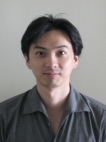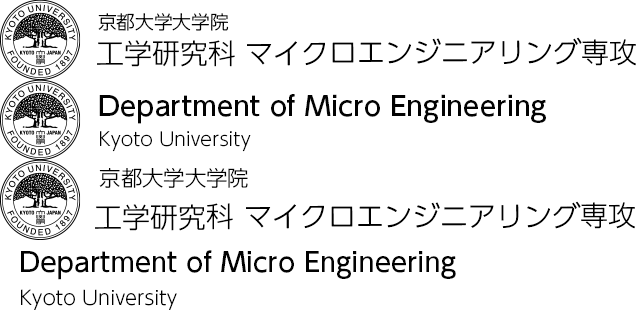Life and Mathematical Sciences
What does it mean to understand the laws of the world? If you take a part of interest from the whole world and make a model, what is the same as what in the world, and what does it contain? From this point of view, our laboratory always thinks about how to express nature of the world as it is as a mathematical and physical model, and what will be discarded and what can be understood by it. We are working on the application to engineering by constructing a new mathematical theory that represents the world.
Academic Staff
* Add "kyoto-u.ac.jp" to each E-mail address.
Yasuhiro INOUE
Professor (Graduate School of Engineering)
Research Interests
Mathematics and biophysics of self-organizing life-like dynamics, Meta-model on dynamics with hyper degrees of freedom.
Contacts
Room b1S09, Building C3, Katsura Campus
TEL: +81-75-383-3670
E-mail: inoue.yasuhiro.4n@
Who is Who?
Prof. Yasuhiro Inoue was born and raised in Okaya, in the central part of Japan. After finishing his junior and high school years in Nagano and his bachelor studies in Physics at Hokkaido University, he went to the University of Tokyo to do his doctoral work on the hydrodynamics of complex fluids - at the Department of Quantum Engineering and Systems Science - under the supervision of Prof. Hirotada Ohashi.
Continuing at the same University, Prof. Inoue moved to the Department of Mechanical Engineering, to complete post-doctoral training in the field of molecular dynamics. He then developed computer models to simulate cell and tissue migration (with special emphasis on fish keratocytes) at the Riken Research Institute. Prof. Inoue then accepted a position as an Assistant Professor at the Department of Mechanical Engineering at Kyoto University.
Later, he served as an Associate Professor at the Institute for Frontier Medical Sciences at the same University, focusing his research on cell migration and tissue deformations from a theoretical perspective. In 2019, Prof. Inoue was promoted to the position of Full Professor at the Department of Micro Engineering at Kyoto University.
Today, Prof. Inoue continues to contribute to the field with his extensive knowledge and expertise. His research focuses on a variety of topics including biological morphogenesis, self-organization, the emergence of collective coordination, linkage mechanisms, the rheology of complex fluids, composite materials, soft matter, molecular dynamics, and network theory.
https://www.youtube.com/@yasuhiroinoue
Masato SENAMI
 Junior Associate Professor (Graduate School of Engineering)
Junior Associate Professor (Graduate School of Engineering)
Research Interests
Fundamental researches in condensed-matter and material physics based on quantum field theory and quantum mechanics
Contacts
Room b1S11, Building C3, Katsura Campus
TEL: +81-75-383-3672
E-mail: senami@me.
Kentaro MORIKAWA
Assistant Professor (Graduate School of Engineering)
Research Interests
His research focuses on understanding life mathematically, primarily exploring the principles of morphogenesis from a geometric perspective. He also works on applying mathematically extracted principles to engineering, proposing new fabrication methods inspired by biological processes. Furthermore, he explores fundamental questions about the nature of understanding life itself through mathematical and philosophical approaches.
Contacts
Room b1N02, Building C3, Katsura Campus
TEL: +81-75-383-3671
E-mail: morikawa.kentaro.4e@
Research Topics
Deciphering the Complexity and Evolution of Adaptive Systems
In systems akin to those found in biology, where the environment and system coexist in a vague overlap, there's an intriguing question about the mechanisms that enable these systems to adaptively complexify their structure and function in response to environmental changes. Through ongoing research based on information geometry, we are exploring the structure and development of such complex adaptive systems.
One might wonder how seemingly disparate phenomena — the molecular evolution through viral endogenization, the formation of an organism through cell aggregation, the emergence of human social behavior, or the complexification of product internals and function creation in artificial systems — could all arise under the same mechanism. However, we posit that they share a common underpinning.
Heterarchical Organization and Control Networks in Biological Systems
Morphogenesis, or organogenesis, is a process governed by the appropriately timed and spatial expression of genes. But how can such macro-scale events, eventually leading to full body size, be controlled by DNA located within the minuscule nucleus of a cell only several tens of micrometers in size? Within this process, it's thought that control networks at different scales, such as gene regulatory networks, protein interaction networks, and cell interaction networks, regulate not only the dynamics at their respective scales but also transcend these scales to enable control.
These networks can mutually feedback organ or tissue shapes during morphogenesis into the state of gene expression. One proposed mechanism involves the crucial role of mechanical fields acting as signals. This concept has been substantiated through numerous studies, such as an exploration into the environmental asymmetry on epithelial morphogenesis (Morikawa et al., 2022).
Active Matter and Its Potentials
Objects or molecules that display a non-Brownian, directional movement are classified as 'active matter.' Cells contain vast active matter systems that serve as the 'source' for various cellular movements. Furthermore, many such cells interact with their neighbors, exhibiting collectively coordinated movements. How is active matter able to move, and what mechanisms underlie the emergence of coordinated movements across scales?
The exploration of these questions is not limited to biological systems. For instance, it becomes critical when considering the coordinated work of multiple robots or the collective functionality (or issues) arising when many autonomously driven cars gather. Using the physics of non-equilibrium systems, we are pursuing research into functional manifestation capturing hierarchy (Jung et al., 2020; Matsuda et al., 2019).
The study of these systems' structure and evolution, alongside ongoing research, will offer valuable insights into the workings of complex adaptive systems, whether biological or artificial.
References: Morikawa, K., Kuroda, D., & Inoue, Y. (2022). Impact of environmental asymmetry on epithelial morphogenesis. Scientific Reports. https://doi.org/10.1038/s41598-022-15343-y; Jung, W., Fillenwarth, L.A., Matsuda, A., Li, J., Inoue, Y., & Kim, T. (2020). Collective and contractile filament motions in the myosin motility assay. Soft Matter. https://doi.org/10.1039/c9sm02082a; Matsuda, A., Li, J., Brumm, P., Adachi, T., Inoue, Y., & Kim, T. (2019). Mobility of Molecular Motors Regulates Contractile Behaviors of Actin Networks. Biophysical Journal. https://doi.org/10.10
